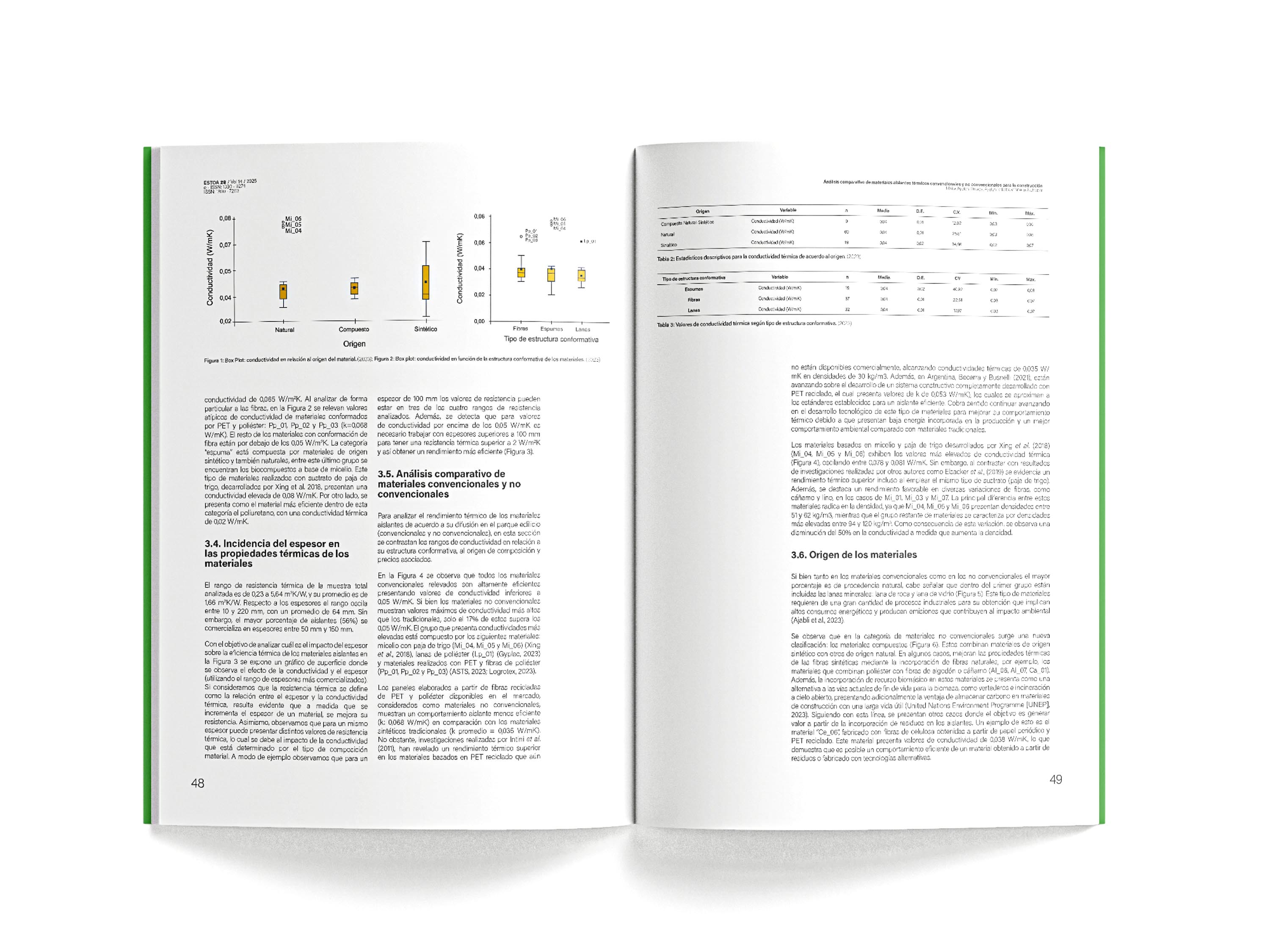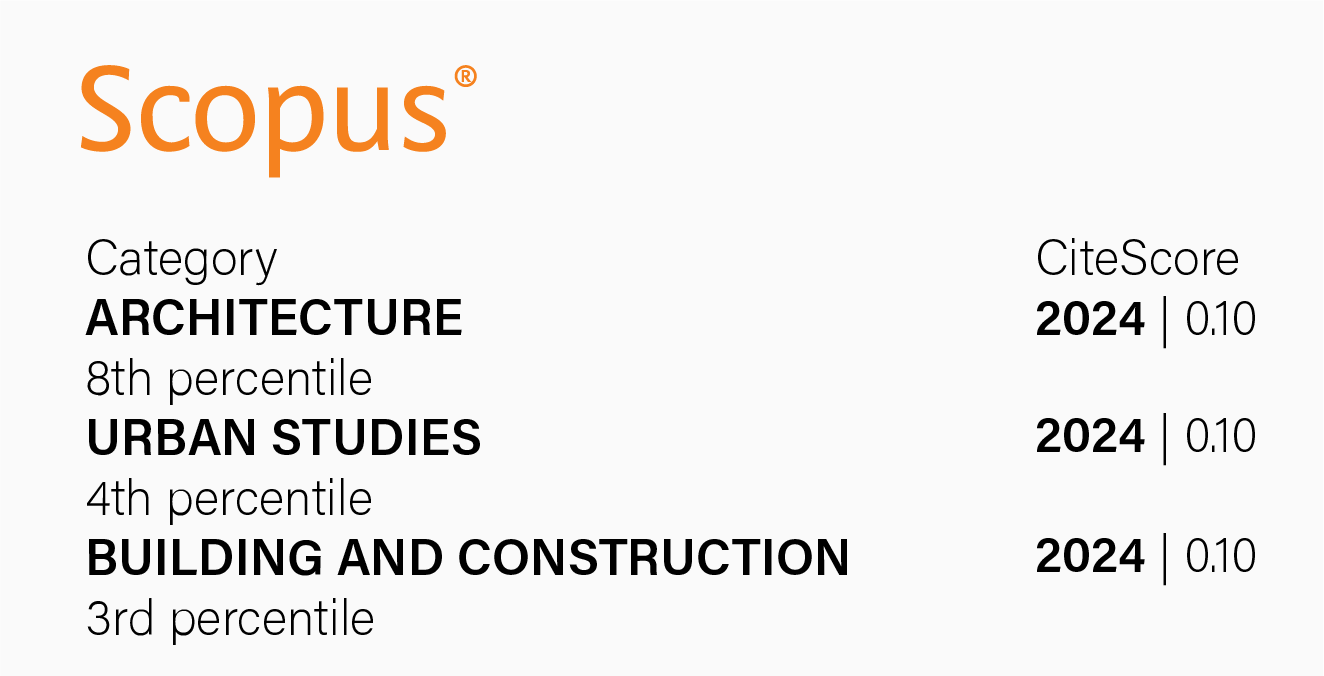Comparative analysis of conventional and unconventional thermal insulation materials for building construction
DOI:
https://doi.org/10.18537/est.v014.n028.a03Keywords:
classification of materials, unconventional building materials, traditional technologies, thermal insulation, thermal efficiencyAbstract
Nowadays, efforts are underway to minimize the negative environmental impact of the construction industry, which results from the use of non-renewable raw materials and the high energy consumption associated with their production. The primary strategy to enhance the energy performance of buildings involves the efficient use of thermal insulation. This study provides a review of resistive thermal insulation materials, considering their thermal and physical properties, prices, and presentations. To analyze these materials, they are classified based on their origin, structure, and relevance in the building envelope (conventional, unconventional). The analysis reveals that synthetic materials exhibit lower thermal conductivity values than natural materials. However, some unconventional materials, known for their environmental benefits, demonstrate thermal performance comparable to that of conventional ones. Additionally, the relationship between price and thermal efficiency is assessed, identifying both conventional and unconventional materials with a favorable price-performance ratio.
Downloads
References
Aditya, L., Mahlia, T. M. I., Rismanchi, B., Ng, H. M., Hasan, M. H., Metselaar, H. S. C., Muraza, O., & Aditiya, H. B. (2017). A review on insulation materials for energy conservation in buildings. Renewable and Sustainable Energy Reviews, 73, 1352–1365. Elsevier Ltd. https://doi.org/10.1016/j.rser.2017.02.034
Ajabli, H., Zoubir, A., Elotmani, R., Louzazni, M., Kandoussi, K., & Daya, A. (2023). Review on Eco-friendly insulation material used for indoor comfort in building. In Renewable and Sustainable Energy Reviews, 185. Elsevier Ltd. https://doi.org/10.1016/j.rser.2023.113609
Albir Ribera, A., Carlos Lerma, E., y Mas Tomás, Á. (2021). Análisis de materiales sostenibles, ciclo de vida y su aplicación en la construcción. Universitat Politecnica de Valencia.
Alchapar, N., & Correa, E. (2015). Comparison of the performance of different facade materials for reducing building cooling needs. Eco-Efficient Materials for Mitigating Building Cooling Needs. Design, Properties and Applications, 155–194. https://doi.org/10.1016/B978-1-78242-380-5.00006-6
Alchapar, N., & Correa, E. (2020). Optothermal properties of façade coatings. Effects of environmental exposure over solar reflective index. Journal of Building Engineering, 32, 101536. https://doi.org/10.1016/j.jobe.2020.101536
Artimestiéri. (2023). Panel de aislamiento térmico y acústico. https://store.artimestieri.com
Asdrubali, F., D’Alessandro, F., & Schiavoni, S. (2015). A review of unconventional sustainable building insulation materials. Sustainable Materials and Technologies, 4, 1–17. https://doi.org/10.1016/j.susmat.2015.05.002
ASTS. (2023). Aislaciones Térmicas, lana mineral de roca basáltica. https://asts.com.ar/productos-termicos-calor-termolana.html
Attias, N., Danai, O., Abitbol, T., Tarazi, E., Ezov, N., Pereman, I., & Grobman, Y. J. (2020). Mycelium bio-composites in industrial design and architecture: Comparative review and experimental analysis. Journal of Cleaner Production, 246. https://doi.org/10.1016/j.jclepro.2019.119037
Bozsaky, D. (2019). Nature-Based Thermal Insulation Materials From Renewable Resources – A State-Of-The-Art Review. Slovak Journal of Civil Engineering, 27(1), 52–59. https://doi.org/10.2478/sjce-2019-0008
Bruscato, C., Malvessi, E., Brandalise, R. N., & Camassola, M. (2019). High performance of macrofungi in the production of mycelium-based biofoams using sawdust — Sustainable technology for waste reduction. Journal of Cleaner Production, 234, 225–232. https://doi.org/10.1016/j.jclepro.2019.06.150
Busnelli, R., y Becerra, A. (2021). Caracterización de nuevos aislantes para envolventes arquitectónicas con materiales no tradicionales. Revista Ingeniería De Obras Civiles, 11(1), 14–24. https://revistas.ufro.cl/ojs/index.php/rioc/article/view/2778
CelulosaPro. (2023). Celulosa Pro Premium. https://celulosa.pro/productos/celulosa-pro-premium/
Conforme-Zambrano, G. D. C., y Castro-Mero, J. L. (2020). Arquitectura bioclimática. Polo del conocimiento, 5, 751–779. https://doi.org/10.23857/pc.v5i3.1381
Cortés-Cely, O. (2015). Propiedades que definen los materiales resilientes en arquitectura. Revista de Tecnología, 14, 117–126. https://doi.org/10.18270/rt.v14i1.1854
Cuitiño-Rosales, M. G., Rotondaro, R., y Esteves, A. (2019). Aportes para el análisis comparativo del comportamiento higrotérmico y mecánico de los materiales de construcción con tierra. Revista de Arquitectura, 22(1). https://doi.org/10.14718/revarq.2020.2348
Danosa. (2023). Danotherm SATE. Soluciones con sistemas de aislamiento térmico por el exterior. https://www.danosa.com/es-es/danotherm-sate/
Elsacker, E., Vandelook, S., Brancart, J., Peeters, E., & De Laet, L. (2019). Mechanical, physical and chemical characterisation of mycelium-based composites with different types of lignocellulosic substrates. PLoS ONE, 14(7). https://doi.org/10.1371/journal.pone.0213954
Feijóo-Vivas, K., Bermúdez-Puga, S. A., Figueroa, J. M., Zamora, P., & Naranjo-Briceño, L. (2021). Fungal mycelium-bioproducts development: A new material culture and its impact on the transition to a sustainable economy. Revista Bionatura, 6(1), pp. 1637–1652). Centro de Biotecnologia y Biomedicina, Clinical Biotec. Universidad Católica del Oriente (UCO), Univesidad Yachay Tech. https://doi.org/10.21931/RB/2021.06.01.29
Fernández, N., Gaggino, R., Kreiker, J., y Positieri, M. J. (2019). Desarrollo Tecnológico de Paneles Multicapa a partir de Residuos Lignocelulósicos Bioligados con Micelio de Hongos. AJEA, 4. https://doi.org/10.33414/ajea.4.370.2019
Geopannel. (2023). Paneles aislantes para construcción. https://geopannel.com/fabrica-textil/paneles-aislantes-construccion/
Girometta, C., Picco, A. M., Dondi, D., Savino, E., Baiguera, R. M., Babbini, S., Cartabia, M., & Pellegrini, M. (2019). Physical-Mechanical and Thermodynamic Properties of Mycelium-Based Biocomposites: A Review. Sustainability, 11. https://doi.org/10.20944/preprints201810.0541.v1
Givoni, B. (1994). Passive Low Energy Cooling of Buildings. John Wiley.
Haneef, M., Ceseracciu, L., Canale, C., Bayer, I. S., Heredia-Guerrero, J. A., & Athanassiou, A. (2017). Advanced Materials from Fungal Mycelium: Fabrication and Tuning of Physical Properties. Scientific Reports, 7. https://doi.org/10.1038/srep41292
Hempflax (2023). Hemp insulation. https://www.hempflax.com/en/applications/construction/hemp-insulation/
Instituto Argentino de Normalización y Certificación (2002). Aislamiento térmico de edificios. Vocabulario. (IRAM 11549:2002). https://catalogo.iram.org.ar/#/normas/detalles/530
Intini, F., Kühtz, S. (2011) Recycling in buildings: an LCA case study of a thermal insulation panel made of polyester fiber, recycled from post-consumer PET bottles. Int J Life Cycle Assess 16, 306–315. https://doi.org/10.1007/s11367-011-0267-9
Isover (2023). Productos de aislamiento. https://www.isover.com.ar/productos?f%5B0%5D=Tipos%20de%20Aislaciones%3A1016
Jones, M., Mautner, A., Luenco, S., Bismarck, A., y John, S. (2020). Engineered mycelium composite construction materials from fungal biorefineries: A critical review. Materials and Design, 187. Elsevier. https://doi.org/10.1016/j.matdes.2019.108397
Logrotex (2023). Aislantes. https://www.logrotex.com/productos/aislantes
Magoal (2023). Aislante de celulosa. https://magoal.com.ar/
Ministerio de Ciencia, Tecnología e Innovación. Argentina, (2020). Plan Nacional de Ciencia, Tecnología e Innovación 2030, Documento Preliminar. https://www.argentina.gob.ar/sites/default/files/plan_cti_2030_-_documento_preliminar_septiembre_2020.pdf
Ordoñez García, A. (2016). Effects of Architectural Design Variables on Energy and Environmental Performance of Office Buildings. [Tesis de doctorado, Universitat Rovira i Virgili]. https://dialnet.unirioja.es/servlet/tesis?codigo=114337
Organización de las Naciones Unidas (2022). Objetivos de Desarrollo Sostenible. Programa De Las Naciones Unidas Para El Desarrollo.https://www.undp.org/es/sustainable-developmentgoals
Papadopoulos, A. M. (2005). State of the art in thermal insulation materials and aims for future developments. Energy and Buildings, 37(1), 77–86. https://doi.org/10.1016/j.enbuild.2004.05.006
Paris Oriol, V. (2014). Análisis ambiental de los aislamientos térmicos utilizados en edificación. Escuela Politécnica Superior de Edificación de Barcelona.
Rockwool (2023). Fichas técnicas. https://www.rockwool.com/es/documentacion-y-herramientas/documentacion-tecnica/fichas-tecnicas/
Sadineni, S. B., Madala, S., y Boehm, R. F. (2011). Passive building energy savings: A review of building envelope components. Renewable and Sustainable Energy Reviews, 15(8), 3617–3631. https://doi.org/10.1016/J.RSER.2011.07.014
United Nations Environment Programme. (2023). Building Materials and the Climate: Constructing a New Future. https://www.unep.org/resources/report/building-materials-and-climate-constructing-new-future
Ursa. (2023). URSA Terra: Lana mineral de vidrio aislante. https://www.ursa.es/ursa-terra/
Xing, Y., Brewer, M., El-Gharabawy, H., Griffith, G., & Jones, P. (2018). Growing and testing mycelium bricks as building insulation materials. IOP Conference Series: Earth and Environmental Science, 121(2). https://doi.org/10.1088/1755-1315/121/2/022032
Zanovello, L., y Cardoso, M. B. (2019). Utilización de lana de oveja de bajo valor como aislante térmico en la Patagonia, Argentina. Energías Renovables y Medio Ambiente, 44, 49–57. http://hdl.handle.net/11336/121341
Zeller, P. y Zocher, D. (2012). Ecovative’s Breakthrough Biomaterials. Fungi Magazine 5, 51–56. https://fungimag.com/spring-2012-articles/LR_Ecovative.pdf

Published
How to Cite
Issue
Section
License
Copyright (c) 2025 Estoa. Journal of the Faculty of Architecture and Urbanism

This work is licensed under a Creative Commons Attribution-NonCommercial-ShareAlike 4.0 International License.
The Journal declines any responsibility for possible conflicts derived from the authorship of the works that are published in it.
The University of Cuenca in Ecuador conserves the patrimonial rights (copyright) of the published works and will favor the reuse of the same ones, these can be: copy, use, diffuse, transmit and expose publicly.
Unless otherwise indicated, all contents of the electronic edition are distributed under a Creative Commons Attribution-NonCommercial-ShareAlike 4.0 International License.



